Before the Falun Gong display had even reached them, the onlookers at this year’s Edinburgh Cavalcade had already been touched by the generous heart of the Falun Gong practitioners. Walking before the parade, practitioners in traditional Chinese dress handed out hundreds of hand-made paper lotus flowers into the outstretched hands of children leaning over the barriers, accompanied by comments from admiring parents, “How beautiful, isn’t it gorgeous!”
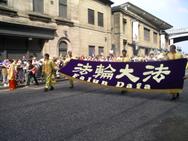 | 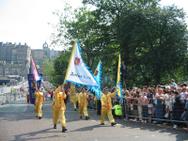 |
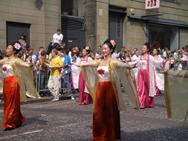 | 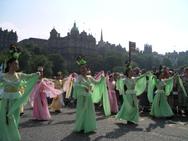 |
It has become almost tradition for Falun Gong practitioners to perform in the famous Edinburgh Cavalcade, which is held every summer at the start of the city’s annual festival, which fell this year on Monday the 8th of August. The parade is a display of traditional Chinese culture, expressed in dancing, drumming and traditional costumes. Despite its origins deep in Chinese cultural heritage, Falun Gong has often been criticised as anti-Chinese by Chinese dictator Jiang. To cover up the persecution of Falun Gong in China, he uses the state-run media to slander the practice. These parades are a powerful way Falun Gong practitioners have found to demonstrate that Falun Gong embraces Chinese culture, and to raise public awareness. These kinds of events are held in response to the persecution in China, which over the last five years has seen tens of thousands of Falun Gong practitioners sent to forced labour camps where they endure unimaginable torture.
 |
This year, practitioners took the opportunity to introduce not only traditional Chinese dancing and drumming, but also spiritual themes associated with cultivation practice. At the centre of the parade, sitting on a float above the heads of the crowds, dressed in orange kasaya, was a Buddha. Behind followed a Taoist, in traditional robe and Bodhisattva Guanyin (An enlightened being renowned for her compassion.) Near the front of the parade, four Heavenly Warriors solemnly guarded the following procession. Before the parade, these performers had been the focus of much attention from many passing photographers who were taken with the magnificence of their costumes.
 |  |  |
The crowd at the parade is always big, numbering in excess of a hundred thousand, and this year was no exception. Between 10 and 15 thousand leaflets introducing Falun Gong were handed out during the one hour duration of the parade. But despite the huge crowd, as the procession made its way along, there was an intimacy between the audience and the performers. People waved at the dancers and the driver of the float, who waved back, laughing and smiling. The driver of the float commented afterwards on how he felt surprised to feel so close to the crowd, catching the eye of many children as they stood watching. As practitioners handing out leaflets dodged the movements of the dancers in the narrow space of the street, the dancers would adjust their movements a little, laughing and sharing the joke with the applauding crowd.
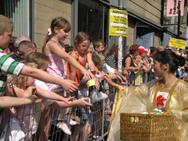 |
Even for those who didn’t get a leaflet, they still had a chance to become more familiar with the practice. Banners described the nature of the practice and huge round boards spelled out Truthfulness, Compassion and Forbearance. Over loudspeakers, public announcers introduced Falun Gong to the crowds, describing it as, “a traditional practice for improving mind and body based on the principles of truthfulness, compassion and tolerance.” Although only a limited number of people were able to take away with them the gift of the beautiful lotus flowers, all who saw the parade could take away with them the memory of a very special display of the tradition of cultivation practice and a better understanding of Falun Gong.
 |  |
* * *
You are welcome to print and circulate all articles published on Clearharmony and their content, but please quote the source.










 more ...
more ...